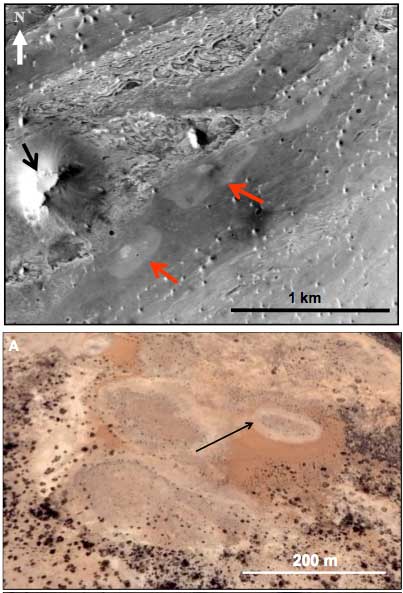
Mounds on Mars that could be from ancient hot springs are described in a new study, after setting the astrobiology community abuzz last spring.
Hydrothermal springs on Earth, like those in Yellowstone National Park, harbor what scientists figure are the closest relatives to the original organisms that lived on our planet. Finding these features on Mars (or any other planet) could have big implications for the question of extraterrestrial life.
Mars has many features that suggest the planet was once warmer and wetter. At the least, the ancient vents - if that's what they are - would make great places to look for signs of past life.
The features found on Mars, imaged on the edge of the Arabia Terra region by NASA's Mars Reconnaissance Orbiter's High Resolution Imaging Science Experiment (HiRISE), have "proved to be a very close match" to hydrothermal springs on Earth, said study co-author Carlton Allen, of NASA's Johnson Space Center in Houston.
The findings, announced today, are detailed in the new issue of the journal Astrobiology, and were presented last April.
The shapes of the mounds and the channels that flow away from them are similar to those seen in the hot spring areas of Yellowstone, Allen told SPACE.com today. They are situated in a deep crater with steep slope and could have been fed by underground water sources on ancient Mars, which is thought to have been considerably wetter than its present-day incarnation, he added.
But Allen and his co-author Dorothy Oehler, also of Johnson Space Center, can't confirm for sure the features' provenance because they don't know what they're made of.
"The thing that we don't have is compositional data," Allen said.
The areas around hot springs on Earth have particular mineral make-ups, and finding similar signatures on Mars would likely clinch the finding. MRO's CRISM instrument could detect this signature except for one problem: Mars' ubiquitous layer of dust.
"There's just enough dust to obscure the spectral features," Allen said. "So we are stymied as far as getting compositions on these particular features."
But if similar mounds could be found in less dust-covered areas, spectra could be taken and the long-standing question of whether Mars once harbored hot springs (and by extension, possibly life) could be answered.
"People have been looking for evidence of spring on Mars for an awfully long time," Allen said.
Spectral features that could have been produced by hot springs have been found on Mars, such as by the Spirit rover in the Columbia Hills, but no obvious corresponding sources have been found.
Allen hopes that the features he and Oehler found will serve as "a template" for others to search images of Mars. He and Oehler conducted such a search of thousands of images this summer, but didn't turn up any more features.
They seem "to be a fairly rare phenomena," Allen said. Though there is the possibility that they once covered the surface, but were subsequently covered up or destroyed by erosion and volcanism, he said.



Reader Comments
to our Newsletter